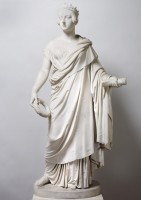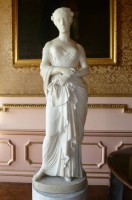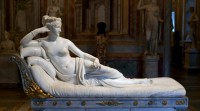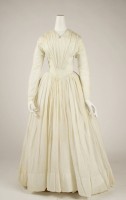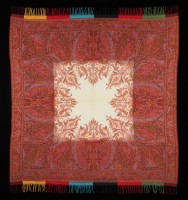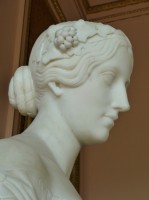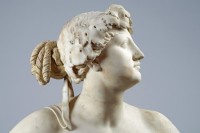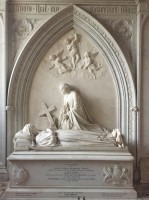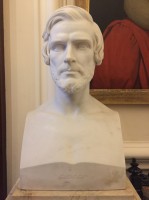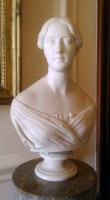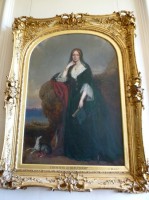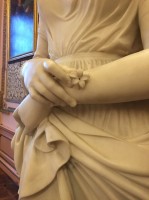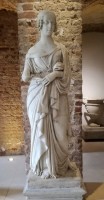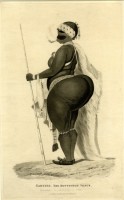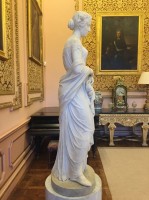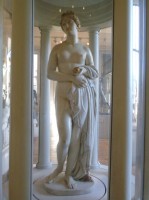The browser will either open the file, download it, or display a dialog.
The nineteenth-century British sculptor John Gibson (1790–1866) is arguably best known for two major works: the Tinted Venus (1851–53), a polychrome figure that was first exhibited at the Royal Academy (RA) summer exhibition in 1839 without color as Venus Verticordia (fig. 1), and his commissioned portrait statue of Queen Victoria dressed in classical robes, which he exhibited at the 1847 RA summer exhibition (fig. 2).[1] Designed, completed, and exhibited between these two works (i.e., 1839 to 1847) is an important third sculpture of an idealized standing female figure that has been overlooked in the scholarship on Gibson: a portrait statue commissioned by the artist’s friend, Sarah Otway-Cave, 3rd Baroness Braye, that represents her widowed daughter Catherine posed, as I will argue in this essay, with the attributes of the Greek mythological heroine Ariadne (fig. 3). In presenting Catherine this way, Gibson was in fact falling in line with other examples of portraits in which the sitter was transformed into a mythological persona. Two of the most famous examples of this practice were made by Antonio Canova, Gibson’s teacher in Rome: Napoleon as Mars the Peacekeeper (1802–6; Apsley House, London), and Paoline Borghese as Venus Victrix, (1805–8; Borghese Gallery, Rome; fig. 4). Gibson exhibited his statue at the 1846 RA summer exhibition with the title Portrait of the Hon. Mrs. Henry Murray—Statue, in Marble, denoting Catherine’s proper name and title at that time.[2] The sculpture was received positively by most critics, although one reviewer compared it, rather surprisingly and harshly, to the Hottentot Venus, a comment that will be discussed in this essay.
With this statue, Gibson succeeded in combining a poetic subject with a portrait, arguably drawing on the principles of idealized beauty epitomized in his earlier goddess of love and foreshadowing the classical inspiration inherent in his later portrait statue of Queen Victoria. In the history of nineteenth-century sculpture, Gibson is best known for his experiments in tinting marble, so his portrait statue of Catherine is even more significant because it underwent a polychrome transformation. Eight years after its exhibition, Gibson was asked by Catherine to color the sculpture in emulation of two other polychrome figures he had by then produced and displayed: Venus and Victoria.[3] Gibson’s polychrome practice was not well received by all, but he encouraged Catherine to “fight it out” with people when they critiqued her tinted portrait.[4]
Catherine’s interest in having Gibson color her portrait at a later date is revealing within the context of co-creativity in art, a term used in recent criticism to describe contemporary art practice that involves either artistic cooperatives as creators, or art projects in which the viewer/audience becomes both the subject of and a participant in the creation of the work. Co-creation has been defined as “the melding of the labour and creativity of multiple people without a specific cross-cultural context” and has been seen as a useful way of examining “innovation and value creation across differentials of power, and between individuals, organisations, groups, corporations and institutions.”[5] Although many successful artists in history, often with large studios of apprentices and assistants, arguably may be considered co-creative producers of art, one still assumes there is a single creative agent: the named individual artist. Gibson was no different in this sense, as he ran a large sculpture workshop in Rome for nearly fifty years and, despite the involvement of numerous assistants, was solely credited as the artist of every sculpture produced by his studio.[6] Furthermore, Gibson was notorious for disregarding the opinions of clients and making works of art as he thought best, even at the risk of losing commissions.[7]
It is exactly for these reasons, then, that the portrait statue of Catherine is significantly different. As will be discussed in this essay, archival evidence suggests that Catherine (perhaps in unison with her mother, Sarah) made suggestions and comments regarding how she should appear in stone. Because models or casts of the statue do not exist, one cannot say for sure how influential Catherine’s contributions were in the sculpture’s development over time. However, the fact that Catherine felt comfortable contributing to the statue’s creation, both during its production and afterward as a tinted sculpture, suggests a form of co-creative agency that challenges the perception of Gibson as a determined artist who believed he alone knew best. This article, then, documents the commission and history of this unique portrait statue, its reception at the RA, and its life as a tinted statue at the height of Gibson’s interest in polychromy. Based on unpublished personal papers, such as extracts from Sarah’s journals, as well as contemporaneous reviews and other secondary sources, this essay encourages a reconsideration of one of Gibson’s most overlooked figures, both in the context of his own oeuvre and as an example of co-creation in the history of nineteenth-century sculpture.
The Portrait Statue
Throughout his career, Gibson made a number of funerary monuments as reliefs or statues with portraits, such as the relief depicting his early patron Emily Robinson (1829; St. James’s Oratory, Liverpool) and the government-commissioned memorial statue of Sir Robert Peel, MP (1850–53; Westminster Abbey, London). Each of these had been a posthumous portrait. The statues of Catherine and Victoria are different in that these women were the only two people who ever sat for Gibson so he could make life-size portrait statues of them. When it came to portraiture in general, Gibson was notorious for refusing to make portrait busts.[8] His aversion to this practice was so well known by his contemporaries that when Viscount Clifden visited his studio in Rome and approached him about modeling a bust of his newlywed wife, he began his conversation by noting, “I am told you decline busts,” to which the artist readily replied, “I do,” only changing his mind when he saw how beautiful Lady Clifden was.[9] Instead, Gibson preferred to make poetic, classical subjects in the spirit of ancient Greek art, declaring frequently, “Whatever the Greeks did was right!”[10] He believed he could only accomplish this practice in Rome, a city he called “the university of art, where it is the one thing talked about and thought about.”[11] To work in London as a sculptor, he believed he would have been forced to focus on monuments and busts and to push aside his interest in classical subjects. He despised the monumental statues in modern-day dress that populated London and other cities throughout England, declaring bluntly: “The human figure concealed under a frock-coat and trowsers [sic] is not a fit subject for sculpture. I would rather avoid contemplating such objects.”[12]
Thus, whenever he did agree to make a portrait bust or statue, Gibson insisted on classical dress, for instance depicting Peel in classical robes, for which he was sharply criticized in the London press when the sculpture was unveiled.[13] He was notedly relieved when Prince Albert, for the commission of the queen’s statue, assured him that they wanted her “classically draped . . . like a Greek statue.”[14] Taking all these issues into consideration, then, it would seem that Gibson only was willing to make the statue of Catherine because he could depict her with classical-style clothing and attributes, and because he found her aesthetically pleasing as a subject. It is worth noting in this context that her nephew, the 5th Baron Braye, described Catherine in his own memoirs as having been a “classically beautiful woman,” a description that undoubtedly would have inspired Gibson.[15] While Catherine’s physical appearance likely appealed to him, his friendship with the sitter and her mother also was an important factor in the commission.
Looking at Gibson’s portrait statues of Catherine and Victoria, which for a few years were being produced in his studio at the same time, it is not surprising to see that they share compositional similarities. Both gaze in the distance to their right and both stand in almost the same contrapposto position, right knee bent, and right foot turned outward from beneath the gown with the heel raised slightly. Both also wear bracelets on their right wrists and are adorned in drapery that falls off the shoulders and rests at the top of the breasts. Over this, however, the queen wears the heavy drapery associated with antique and contemporary leaders and orators. She carries in her hands a laurel wreath and a scroll and wears a crown on her head, elements befitting a monarch. As such, she is both a political figure and an idealized woman.[16] Catherine has no such allegorical potential; her grandeur rests only in her physical presentation.
At first glance, there appear to be few similarities between these statues and Venus, as the goddess is represented in the nude, except for a tunic over her arm. However, like the statues of Catherine and the queen, Venus stands in contrapposto and gazes to her right. The drapery arranged in Venus’s and Catherine’s arms cascades downward in “long, flowing lines.”[17] Both are shown with breasts higher on the body than is perhaps natural, but this feature helps present a taller, leaner figure and arguably corrects foreshortening when viewed from below. The genteel demeanor of both Venus and Catherine is reinforced by their alternately crossed arms, a gesture Gibson noted was deliberate: “I had often remarked that ladies when holding a fan or any light object generally place their hands in repose in front of the person.”[18] In this way, Gibson’s Venus is not a young, seductive goddess, but rather, in his words, a figure whose “spiritual elevation of character . . . results from purity and sweetness, combined with an air of unaffected dignity and grace.”[19] That description aptly applies to the statue of Catherine as well.
Measuring sixty-seven inches in height, Catherine appears in the statue dressed in diaphanous drapery that reveals the contours of her body beneath. The top of the dress is arranged loosely across her breasts, barely covering them; the dress is held up rather implausibly by just the short sleeves on her upper arms. The drapery, although suggestive of a classical robe, in fact has similarities to women’s clothing at this time. An example of a dress from the early 1840s shows contemporary fashion trends for women, including a lower waist with a v-shaped bodice in the center front, and a full-length skirt that expands outward from the waist and hips because of the corset and petticoats beneath (fig. 5).[20] Catherine appears to be wearing a version of an evening dress with short sleeves, but the full skirt has been pulled closer to the body. In this way, her figure has lost the silhouette that was fashionable at this time, giving the dress instead a classical look in the way it drapes her body.[21] Catherine also wears a shawl, an appropriate accessory for all stylish women of the day. Initially shawls were luxury items made in Kashmir, India, but by the 1830s they were woven in factories primarily in Paisley, Scotland (fig. 6).[22] Both the square shawl (measuring from three to six square feet) and the long shawl (measuring about ten by five feet) were intended to be folded and worn around the middle and lower back, with the ends resting over the arms in the front.[23] This is how Catherine wears the shawl in this statue, but here again Gibson has classicized it, removing any pattern and designing it to cascade in a series of beautifully carved folds that end in a tassel knot that centers the vertical axis of the figure.
This detailed look at the costume in the sculpture shows, then, how Gibson sought to maintain a classical look to his figure, but it arguably also demonstrates that his sitter likely insisted on controlling this component by still appearing in contemporary, fashionable clothing. When the statue was exhibited at the 1846 RA summer exhibition, one critic noted Gibson’s success in having transformed her modern dress into classical form: “With [a female model], there is some possibility of idealizing a faithful reproduction of the real, and taking poetical freedoms with those modern conventionalities of costume which, absolutely refusing themselves to the handling of the art, cover, at the same time, all on which Sculpture should work.”[24]
In Gibson’s statue, Catherine also wears a serpentine bracelet on her right wrist while her right hand, which clasps a jasmine flower, rests on her left wrist. Her hair is parted in the middle and arranged in waves toward the back, according to the fashion of the day, but it is wound with a ribbon into a bun of three coiled layers (fig. 7). She wears a tiara-like wreath of ivy leaves and grapes, which suggests that the figure, on its own, could be a bacchante/maenad, a follower of Bacchus/Dionysus, the god of wine and the harvest. The inclusion of the serpentine bracelet suggests further that she may represent Ariadne, who was associated in mythology with the fertility snake goddesses of Crete and who was well known as the companion of the god of wine who rescued her after she was abandoned by Theseus.[25] Even the jasmine flower, which came from Asia, connects to Bacchus/Dionysus, whose mythological origins have him coming from the East. The arrangement of the hair, moreover, has precedent in a contemporaneous sculpture that Gibson would have known well: Ariadne Riding on a Panther (1803–5; Liebieghaus Skulpturensammlung, Frankfurt) by Johann Heinrich Dannecker (fig. 8). A comparison of the side views of these two works shows interesting similarities in the wreath of leaves and fruit in the hair, as well as in the three-coiled bun at the back of the head.[26]
Presenting Catherine both as a portrait statue and a poetic representation of a mythological heroine was certainly not unusual at this time. Gibson would have been familiar with British grand manner portraits by Joshua Reynolds, George Romney, and others, which not infrequently represented women in the guise of the Muses or classical goddesses, as well as with the Venus Victrix by Canova (fig. 4). Indeed, the theatricality implicit in posing his subject as a goddess would have been appropriate, as Sarah’s unpublished journals reveal that Catherine was an avid fan of the theater and opera, and she enjoyed organizing and participating in tableaux vivants. Catherine wrote to Gibson in 1843 about staging one of these events at which she “represented the Magdalene of Carlo Dolci (of Florence) in a frame, then the ‘Poesia’ and lastly the Madonna of Sasso Ferato in a blue mantle.”[27] Thus, Catherine-as-Ariadne would not be completely out of character and certainly would fall in line with Gibson’s desire to give his portrait statue a classical reference.[28]
The Patron, the Sitter, and the Sculptor
In order to contextualize the commission of the sculpture, one must know more about Sarah and Catherine, their friendship with Gibson, and why there are no Gibson portraits of Sarah’s other children, at least one of whom (Maria) was in Rome with them at this time. Sarah Cave (1768–1862) was the daughter of Sir Thomas Cave, 6th Baronet; their family seat was Stanford Hall, situated along the River Avon on land bordering Leicestershire and Northamptonshire.[29] The baronet’s immediate heir was his son, also named Sir Thomas, a member of Parliament for Leicestershire who died at the age of twenty-five in 1792, married but without children. The Cave baronetcy followed male primogeniture and shifted to Sarah and Thomas’s uncle, the Rev. Charles Cave of Finedon, who became the 8th Baronet.[30] Stanford Hall and its contents, however, were bequeathed to Sarah, putting her in the position of owning the manor house and its land but not holding the family’s title.
In 1790, Sarah had married Henry Otway, whose family seat was Castle Otway in County Tipperary, Ireland. She gave birth to nine children, three of whom died young. Her two adult sons (Robert and Thomas) eventually died before her without issue, and she was survived by her four remaining daughters (Maria, Anne, Catherine, and Henrietta).[31] According to her grandson, Sarah “led an unhappy life owing to the violence of Otway’s temper.”[32] She eventually separated from him and moved in with her mother, as the laws of the day gave her husband full control of Stanford Hall, where he resided with some of their children.[33]
In 1818, three years after her husband’s death, Sarah changed her family’s legal name by royal license to Otway-Cave, incorporating her maiden name and reasserting her legal ownership of Stanford Hall. Twenty years later, she appealed for the right to be named Baroness Braye. Her claim related to her great-grandparents, Sir Thomas Cave (3rd Baronet) and his wife, the Hon. Margaret Verney, who was a direct descendant of the 1st and 2nd Baron Brayes, both of whom had served under Henry VIII. The Braye barony was created by a writ of summons, meaning the 1st Baron was called to Parliament under the Tudors and received a barony to do so. The title could in fact be inherited by women, but primogeniture only applied to male heirs; thus, the Braye barony fell into abeyance among the sisters of the 2nd Baron Braye after his death in 1557.[34] It was resolved in Sarah’s favor in 1839 when she was granted her title suo jure (in her own right) by Queen Victoria.[35]
Of all Sarah’s children, Catherine (1806–75) was her favorite, as evidenced by the frequent appellation of “dear Catherine” in her journals; none of her other children received a similar term of endearment. Catherine was one of the children separated from Sarah when she left her husband, and from Sarah’s journals it seems as if Catherine also suffered from physical ailments throughout much of her life, more so than her siblings, and it may be possible that Sarah had greater health concerns for Catherine than any of her other children.[36] Even though they were close, Sarah was vehemently opposed to Catherine’s marriage to Henry Murray, which took place on October 19, 1826.[37] The couple indeed had a troubled marriage, and Sarah sought to protect her daughter, likely recalling her own troubled marriage. Murray died five years later in 1831. With her mother’s accession to the title of Baroness Braye in 1839, Catherine and her siblings were granted the titles of honourable. This explains why Gibson’s statue of her was exhibited in 1846 under the title of the Hon. Mrs. Henry Murray. In 1850 Catherine married the widowed John Reginald Pyndar, 3rd Earl Beauchamp, making her Countess Beauchamp; however, this marriage also was brief, as the earl died early in 1853.[38] Catherine lived with her mother almost her entire adult life, and even during her brief second marriage she lived for at least some time with her at 14 Great Stanhope Street in Mayfair, London.[39]
Catherine had no children and died thirteen years after her mother.[40] She had commissioned her mother’s funerary monument and was buried with her in St. Nicholas Church at Stanford on Avon, the same church where most of the Cave family had been buried for centuries (fig. 9). Their monument depicts Sarah in a sleep-like death, lying on a bed with her dog Bernini resting at her feet, and Catherine as a Magdalene-like mourner kneeling beside her, carved in relief within a gothic arch. Although details on the actual commission are unrecorded, it is known that the monument was made by Mary Thornycroft.[41] Catherine likely asked Gibson for assistance in this commission, but at this late date in his career he rarely made funerary monuments and undoubtedly referred Catherine to Thornycroft, who with her sculptor-husband Thomas had worked briefly in his studio in Rome and now were active in London.[42] This suggestion of Gibson’s involvement in the commission is supported by the fact that he did design the relief of the three putti that fly over Catherine’s head, representing Sarah’s two sons and one daughter who had died as children. Gibson’s design was executed by a sculptor named Fontana, possibly Giovanni Fontana who was active in London in the 1860s.[43]
Gibson may have first met the Otway-Cave family when Sarah went on a grand tour with her children in 1821. At that time, Gibson had only been in Rome four years and had recently opened his own studio after working and studying with Canova. Sarah toured various sculptors’ studios on this trip and noted in her journal for April 3: “Was at Gibson’s studio of sculpture, . . . a bust of Lord Colchester . . . very well done, a Nymph very beautiful.”[44] If they did not meet at that time, they certainly knew one another by the mid-1830s when Sarah and her family returned to Rome. During the 1842 winter season tour of Rome, when Sarah commissioned the statue, she recorded numerous instances in her journal of Gibson joining them for dinner; accompanying them on visits to the Roman studios of sculptors such as Lawrence Macdonald, Richard James Wyatt, and Thomas Crawford, and painters such as Thomas Cole and Johann Friedrich Overbeck; and even escorting Catherine on a torch-lit tour of the Vatican.[45]
The friendship that Sarah, Catherine, and Gibson shared clearly was strong, so much so that mother and daughter felt immediately comfortable turning to him for anything related to sculpture. Indeed, Gibson is even named in Sarah’s journals in association with a funerary monument on the grounds of Stanford Hall for Bella, an Italian greyhound that was her constant companion.[46] The family also acquired a bust of Gibson made by his former pupil William Theed the Younger, which joined their collection of family portraits throughout the home (fig. 10).[47] In his memoirs, Gibson wrote that Sarah and Catherine “became my most kind friends for years.”[48] During the summer of 1844, his first journey back to England since departing for Rome in 1817, he attended more than one dinner party at Sarah’s London home, on at least one occasion sitting beside Catherine and the Irish writer Lady Morgan.[49] On a subsequent trip to England, he visited the women for a few days at Stanford Hall, writing from there to his friend, the painter William Boxall: “My Lady friends here are so kind & have used their eloquence to induce me to stay longer so I shall stay until Saturday.”[50] And in 1862, when the Tinted Venus was on display at the International Exhibition, Gibson noted in his journal that he visited the World’s Fair with Catherine on more than one occasion, showing her in person the famous polychrome sculpture that would forever be attached to his name.[51]
The Commission
The earliest reference to the commission of Catherine’s portrait statue dates from March 5, 1842, when Sarah wrote in her journal: “I saw Gibson, & named to him what I wished to have done.—shall see him again next week. he was quite delighted with my proposition, & I can have no doubt the results under his able hands will be all I can wish.”[52] This entry may seem vague at first, even though the reference to “his able hands” suggests a sculpture, but the meaning behind Sarah’s words is clarified by a follow-up entry two weeks later: “I found Gibson at his Studio & told him, a Figure was fixed upon, but alas! since then I fear the Time will not admit of it.”[53] These two entries, then, suggest that when Sarah first approached Gibson about commissioning Catherine’s likeness in marble, it was to do a bust, and then, possibly after discussing things further with him, she resolved to commission instead a life-size statue.[54]
There is in fact at Stanford Hall a bust of Catherine that long has been assumed to be by Gibson because of its association with the statue (fig. 11). Unlike the statue, though, the bust looks more contemporary, idealizing Catherine’s features but giving her a hairstyle and clothing much more representative of her day. Because the bust is unsigned and undated, it is understandable why heretofore it had been attributed to Gibson. However, in Catherine’s will the bust is identified as being by Lawrence Macdonald, Gibson’s friend and sculptor-rival in Rome.[55] Macdonald, who was from Edinburgh, was well known in Rome for making portrait busts of people on the grand tour, producing more than 150 in his career. This bust of Catherine must date from around the same period as the statue, but to date no information on the commission from Macdonald has been traced.[56]
Sarah’s fears about time, as expressed in her journal, related to the fact that she and her daughters were returning to London in mid-May and she was uncertain how long it would take for Gibson to begin work on the statue. On March 26, however, she noted: “saw Gibson, & had the pleasure to find there will be time for the Figure to be modelled.”[57] According to Sarah’s journal, Catherine sat for Gibson at least ten times, starting on March 30 and ending on or around April 23.[58] The sittings were interrupted by Catherine suffering from “a sort of influenza” on April 9, and although she resumed her sittings a week later her mother felt she looked “very delicate” and that her eyes were “still heavy.”[59] Catherine’s sculpted face does not show any evidence of her illness. By April 19, the clay model of a bust was advanced enough that Sarah was able to write that she was “much pleased” with it.[60] During these ten or more modeling sessions, Gibson also likely took Catherine’s measurements for the portrait statue and undoubtedly made plaster casts of her arms and hands. This was a practice not uncommon in Rome at this time and something Gibson reportedly also did for his statue of Queen Victoria when she modeled for him in 1844.[61]
Gibson’s account books document at length both the income and expenses for this sculpture.[62] He charged Sarah £500 for the portrait statue, which she first paid in two undated installments of £150 each.[63] The first of these payments would have taken place at the time of the commission, and the second about halfway through the process, which was standard practice. Gibson noted that as of May 1, 1846—when the statue was to be exhibited at the RA—he was still owed £200, but at a later, unspecified date all the installment information was crossed out and he wrote “all paid.” Among Gibson’s expenses for the sculpture were:
• 170 scudi for the block of Carrara marble;
• 6 scudi for carriage transportation of the marble to his studio;
• 7 scudi and 7 baiocchi for the armature and large-scale clay model;
• 15 scudi for the plaster casting;
• 190 scudi for pointing (a task usually assigned to his studio worker Babboni);
• and 14 scudi for polishing.
A studio worker named Celzo spent at least 107 days carving the statue in marble, for which he was paid a total of 86 scudi. Gibson calculated his total expenses at 494 scudi and 35 baiocchi, which he then converted in his account books to £107. This means that the commission earned him a profit of £393, not an insignificant amount of money for a sculptor working in Rome at this time. Despite a close friendship, business was still business for Gibson when it came to commissions.
In May 1843, just over a year after the commission and modeling had begun, Gibson wrote to his friend Margaret Sandbach that the large-scale clay model for Catherine’s statue was completed and, three months afterward, that work was underway on the plaster cast.[64] To date no extant documentation from Sarah or Catherine about the sculpture while it was being made has been identified, with the exception of a letter Catherine wrote to Gibson in September 1843, providing some insight into the commission and suggesting aspects of co-creativity as the work progressed. Gibson had written to Sarah in April of that year (a letter currently lost) informing her of the completion of the clay model. Catherine replied for her mother five months later, apologizing for the delay due to an illness and remarking:
How kind of you to give Mama such an exact description of the Statue. She has no doubt the attitude you have chosen is perfect and the drapery very graceful. Every one who comes from Rome is in raptures with it as a Work of Art, and I have strong suspicions that it is so far superior in beauty to the Original that it will throw me quite into shade, so that when it arrives in England, I shall be obliged to hide my diminished head.[65]
When Catherine posed for Gibson, there must have been discussion about including a dog in the composition, something Gibson seems not to have wanted. Catherine continued in this letter: “I certainly did think I should like a Dog to be introduced, but we must of course bow to your superior judgement.”[66] The dog likely would have been Bella the greyhound, Sarah’s faithful companion who, as noted above, died the following year on the grounds of Stanford Hall. It is Bella who likely appears with Catherine in a contemporaneous portrait painting by Richard Buckner, a British artist working in Rome at that time (fig. 12).[67] At around the same time the commission for the sculpture was taking place, Gibson had completed the first version of his sculpture The Hunter and His Dog and would soon be making a repetition of this subject for Earl Yarborough (ca. 1847; Usher Art Gallery, Lincoln, England). In addition, his brother Benjamin at this time was working in the Gibson studio on a sculpture entitled A Shepherd and His Dog (untraced).[68] In another studio just around the corner from Gibson’s, his close friend and sculptor-rival Richard James Wyatt was working on a commission for the queen: Penelope with the Bow of Ulysses (1841–44; Royal Collection; fig. 13), in which the forlorn wife of the Trojan War hero, dressed in classical drapery, is shown standing beside Argos, her husband’s faithful dog. With such a profusion of dogs in sculpture at the time, it is not surprising that Catherine was interested in including Bella in her statue. However, Gibson clearly must have felt that including a dog would have been repetitive, and he undoubtedly wanted to emphasize Catherine individually and focus on her idealized beauty.
Catherine also discussed with Gibson the inclusion of a specific flower, a “natural Lily,” and accompanied with her letter a pencil sketch by Joseph Severn that depicted this particular flower that she had worn recently in her hair. She wrote:
It is a new species, the form beautiful and of the purest White you ever saw. I am sure it would be exquisite in marble. If not too late, do let me petition for this, instead of the Rose, as it is so much more uncommon, & quite a Celestial looking flower. The name of it is “Lilium exceniusus [sic].” . . . Lady Powerscourt was represented with the Lotus, so that this would make a variety if you happened to approve.[69]
Floral symbolism in British art at this time was important for the message it could convey to viewers.[70] According to at least one nineteenth-century book on floral language, the rose was a symbol of love and passion, associated with the goddess Venus, while the lily was said to represent purity and majesty and had direct connotations with the Virgin Mary.[71] Gibson was aware of the importance of flowers in art, incorporating, for instance, a rose into the hands of two figures from the 1830s—Flora (Walker Art Gallery, National Museums Liverpool) and two repetitions of Cupid Disguised as a Shepherd Boy (e.g., Yale Center for British Art, New Haven)—arguably reinforcing ideas of passion and seduction in these works. In the case of Catherine’s statue, however, Gibson chose neither a rose nor a lily, but rather a jasmine flower, which she holds delicately in her right hand (fig. 14). In contrast to these other flowers, which might have been more appropriate for a younger, possibly virginal, woman, jasmine symbolized amiability, and in central Italy the flower was worn by women as a symbol of marriage.[72] Jasmine, thus, may have seemed more appropriate for a widow in her mid-thirties who hoped to marry again, as indeed Catherine did a few years later.
Catherine also mentioned in this letter Viscountess Powerscourt’s statue, suggesting she was very conscious of wanting hers to look different (fig. 15). This portrait statue of the viscountess was made in Rome by Macdonald, Gibson’s aforementioned Scottish sculptor friend. It originally must have depicted her holding the lotus (a symbol of eloquence), but the right hand and flower today are damaged and no longer visible.[73] It is worth recalling that Macdonald had also made the bust of Catherine; she undoubtedly would have seen at least the plaster cast of the statue of Lady Powerscourt in Macdonald’s studio when they were in Rome and remembered this when she wrote to Gibson the following year. This detailed letter from Catherine, thus, provides further evidence of what has been argued in this essay is an example of dual agency with regard to her sculpture. Catherine certainly was aware that offering contributions, whether utilized or not, were outside the norm for a commission with Gibson, for she also wrote in this same letter, “You see I am very bold in giving my opinion, as of Old.”[74] Gibson seems not to have minded.
Exhibition and Polychromy
Gibson’s sculpture was completed by the spring of 1846. A full member of the RA for ten years, Gibson was entitled to exhibit works at the annual summer exhibition and readily did so at this time with new examples of his work produced in Rome. Reviews of the 1846 RA exhibition decried the overall lack of sculpture in the round on view and largely critiqued those on display as poor in quality.[75] The exceptions to these critics’ dismay were a portrait statue of Lord Exmouth (1846; National Maritime Museum, Greenwich) by the London-based Irish sculptor Patrick MacDowell, and Gibson’s portrait statue of Catherine.
The Critic declared Gibson’s figure to be a “fine” work “conceived and executed in the happiest taste.”[76] The Athenaeum, which was not typically kind to Gibson, in this instance praised Gibson’s works, referring to the figure of Catherine as “an expression of power” and noting further that there was “no finer work in the Exhibition.”[77] The reason for their esteem was because the model for his figure was a beautiful woman:
With [a female model], there is some possibility of idealizing a faithful reproduction of the real, and taking poetical freedoms with those modern conventionalities of costume which, absolutely refusing themselves to the handling of the art, cover, at the same time, all on which Sculpture should work. But there is no getting rid of the impracticability of costume where the soldier is to be represented “in his armour as he lived”; and no converting them even to use, where a formal personnation is intended. . . . Mr. Gibson has dealt with his work like an antique sculptor; and in his hands, portraiture is carried into the region of high Art. The figure is all but naked; yet the draperies which the sculptor has employed are disposed with such exceeding skill as, not only to give the aids of support and variety to his composition but, to give to the statue the appearance of being clothed. All the freedom which his art required is obtained, with consummate mastery, by means, and with a result, from which the Roman matron would not have shrunk.[78]
The critic duly noted Gibson’s success with this statue in merging a portrait with the poetic (“high Art”), in other words elevating his subject to the status of a classical goddess. This was a feat which, in the reviewer’s opinion, only can happen with a female subject because depictions of men require clothing that define their active, heroic status: men are defined by what they do, women by how they look. For this critic, as discussed earlier in this essay, Gibson mastered how to present a Catherine as a classical figure, emphasizing her drapery and her anatomy, sensually revealing the contours of her body beneath the folds of her modified contemporary dress.
Despite these positive reviews, there was one rather scathing criticism of the statue. A critic for the Literary Gazette declared it to be one of the worst on display and went so far as to describe it as “a rival to the (Hottentot) Venus.”[79] A failed comparison to Venus, an example of which Gibson had shown seven years earlier, would have been harsh enough, but to compare the figure to the Hottentot Venus, in the minds of Gibson and Catherine’s contemporaries, would have been horrifying, to say the least. Saartje (Sara) Baartman, who had died thirty-one years earlier in 1815, was a South African woman put on display throughout Europe in the early nineteenth century under the show name the “Hottentot Venus,” a term intentionally degrading in that her dark skin color and physiognomy failed to meet the white, Western canon of classical beauty. Most noteworthy, and frequently seen in prints of the day, were her buttocks, which, shown in profile, were large and balloon-like in their exaggeration (fig. 16). Alison Wright has noted that these profile representations of Baartman were used as “rhetorically powerful visual” devices to reinforce racial distinctions of the day.[80] In his remark about Gibson’s statue, the critic was making specific reference to viewing the statue of Catherine from the side, where the fashionable shawl wrapped around her waist, combined with the petticoats beneath the dress, emphasized her buttocks in a manner that broke with standards of classical beauty in the statue itself (fig. 17). From the critic’s perspective, the modification of contemporary dress into classical drapery was an abysmal failure.
By comparing the figure to the Hottentot Venus, the critic may have been insulting Catherine’s beauty overall; certainly he was intimating that Gibson was a failure as an artist. To refer to someone as a Hottentot in Britain at the time was “an insult to describe a rude, uncultured or stupid person.”[81] The critic continued to insult the artist by suggesting he give up portrait sculpture entirely:
The shoulders and arms are beautiful, but, as a whole, it is a sad failure, and much to be regretted; for Gibson has done so much, and so much that is really exquisite, that when we observe he cannot produce (or has not yet produced) a portrait statue, we feel he ought not, for his fame’s sake, to undertake such things. Can we hope that the statue of our Queen . . . will be what it ought to be? Chantrey knew he could not manage the nude figure, therefore never attempted it; and it was most wise in him, though he had gathered together and held commissions till his death.[82]
The recently deceased Francis Chantrey was renowned for his busts and statues depicting sitters in modern-day dress; the naturalism inherent in his work epitomized for many the “British” style of sculpture at that time.[83] Thus, to compare Gibson to Chantrey was to say that Gibson, an expatriate classicist, was neither a good sculptor nor even “British” in his artistry, and thus he had no right to make statues of England’s citizens, let alone their monarch. This nationalist concern was based on the fear that Gibson would represent the queen as a classical goddess, a fear that in fact was not completely unfounded because of his interest in eschewing modern-day dress.
It is unknown how Catherine or her family responded to this criticism. Gibson, for his part, frequently disparaged these London critics, whom he saw as incapable of understanding the height of artistic excellence based on Greek sculpture. As a result, Gibson likely dismissed this critique as well. Indeed, his disregard of critics was no more determined than when he began exhibiting his polychrome sculpture, declaring, for instance, to Prince Albert about the criticism of his tinted statue of the queen: “Ignorant scribblers! . . . I have always a contempt for them, and as to the colours, as I live, they shall have a stronger dose of Polychrome.”[84]
The full history of Gibson’s polychrome practice is beyond the scope of this essay, but it is worth noting that his practice was based on archaeological discoveries of ancient sculptures with color, and that he sought to revitalize this ancient practice for a modern audience. Most relevant to this essay is that Gibson’s first public exhibition in London of one of his tinted statues was that of the queen in 1847.[85] Rather than color the entire figure, though, he highlighted parts of it, tinting in yellow the decorative dolphins (symbols of British naval power) and the bottom edge of the tiara, as well as the decorative acorns that weighted the robe near the bottom. He also reportedly painted the sandals yellow, but later gilded them. The embroidered trim of the robe and the details of the rose, shamrock, and thistle (symbols of England, Ireland, and Scotland) were made red and blue.[86] Inspired to experiment further with polychromy, in 1853, after completing a new repetition of Venus Verticordia for Mr. and Mrs. Preston, Gibson made the decision to tint this as well (fig. 18). The sculpture remained for the next six years in his studio, where it became a must-see for grand tourists in Rome. In 1859, it was finally sent to its owners and later exhibited publicly in London at the 1862 International Exhibition.[87]
Aware of the excitement that the display of his Tinted Venus had caused in Rome, and likely having seen the tinted statue of the queen at the RA, Catherine made the remarkably bold move to have Gibson tint her portrait statue, a decision that demonstrates even further her role as co-creative agent of this work. This tinting took place during his visit to England in the summer of 1854 and was completed by early August, when Gibson wrote to Mrs. Preston, “Some few years ago I made a marble statue of the daughter of Lady Braye & since my return, now, I have painted the statue and the ornaments are gold.”[88] Gibson described in his memoirs the coloring of Catherine’s statue: “The head is adorned with ivy, which is gold, as well as her other ornaments; the dress is enriched with a border of red and blue, a slight flesh tint, and blue eyes.”[89] The use of gilding, as well as blue and red on the clothing, was comparable to what he had applied to his statue of the queen. The blue eyes, however, related directly to Venus, whose eyes were tinted blue. The reference to a “slight flesh tint” is vague and difficult to assess, but it is known that Gibson gave Venus a pink hue to warm the figure so that it seemed more like ivory.
Although Gibson does not mention it in his memoirs, he apparently also tinted the hair of the statue yellow, according to a letter written by his friend Susan Horner (sister-in-law of the geologist Sir Charles Lyell). Horner viewed the statue at Sarah’s home in London when she visited them with her mother and sister in early July 1859, five years after the tinting had taken place. Horner’s first-hand response to the statue and the effect of its polychromy is worth noting:
The first feeling with the statue was surprise, the yellow hair did not quite please me, because one uniform colour but the longer I looked the more I liked it, & Mamma & my sister felt the same, until we all exclaimed “How beautiful”! It was like a statue waking into life a sort of vision, not mortal flesh & blood, but a soul in the spiritualized form. If we are all to look anything like that in another world, we need not all have straight noses to look beautiful. If it were not presumptuous in me to write praise to you, I could say much on the elegance of form, of the thought conveyed to us & of the drapery. We were indeed quite delighted.[90]
Catherine, however, reportedly regretted her decision soon after Gibson tinted the statue. During a dinner party, people had criticized its appearance, and she wrote to Gibson about this. He responded, “Lady Beauchamp, do as I do, fight it out with them, it does not signify whether they like it or not.”[91] He then invited some of his friends and closest allies in polychromy to visit and convince her of its success. This group included Sir Charles and Lady Elizabeth Eastlake, Anna Jameson, and the architects Sir Charles Barry and Charles Cockerell. Gibson reported of this visit: “The effect soon began to impress them agreeably, and the longer they dwelled upon the statue, the more they admired the charm of Polychromy.”[92]
Catherine left the statue tinted for the remainder of both Gibson’s and her lives. Her nephew noted that in 1875, when his aunt died, the “splendid statue . . . tinted—a novel aid to art” was then on view in the main reception room of her home at Grosvenor Square where all visitors could see it.[93] Only after the statue was moved to Stanford Hall was the polychromy removed, likely due to changes in taste, although it is unknown when this took place. This is comparable to what happened to the tinting of Gibson’s statue of the queen and suggests that in both instances the coloring, using wax-based pigments, was not necessarily intended to be permanent. Indeed, Gibson himself noted that the tinting could be removed with a sponge, soap, and water, if desired.[94]
Afterlife
When Gibson died, he bequeathed the contents of his studio and £32,000 to the RA to establish the Gibson Gallery, where future students could study from marble statues, plaster casts, and drawings of his work.[95] Among the numerous casts sent to London from Rome was that of Catherine’s statue. The gallery officially opened to the public in November 1876, but plans for it were underway for some time beforehand, and presumably some of the plaster casts and marble statues may have been on temporary display in various parts of the RA. Catherine visited the RA and she was startled and embarrassed to discover the cast of herself installed on a landing of the staircase. Writing to Sir Francis Grant, president of the RA, in what is likely one of the last letters she wrote before she died, Catherine requested that the statue be moved into “some remote corner of the Gallery . . . even if the Light should not be so favourable,” so that it would be closer to Gibson’s other statues, most notably those of the queen and Venus.[96] It is unknown if the cast was moved, but when the gallery opened it does not seem to have been installed with the rest of the artist’s work.[97] Sadly, the cast no longer survives, as it might have been instrumental in helping assess if there were any changes between the cast and marble, particularly in light of missing documentation about the development of the figure itself, and Catherine’s proactive interest in the statue’s creation and tinting.
The loss of the cast, then, reinforces the importance of the marble portrait statue at Stanford Hall as a unique work in Gibson’s oeuvre, without any casts, repetitions, or reductions ever made after it. That the sculpture was his first commission for a portrait statue of a living adult is important in its own right as part of Gibson’s oeuvre. That the sitter was both actively involved in its development and subsequently sought to have it tinted—during a period when most in England were unaware of the visual implications of this effect or practice—demonstrates even further the significance of this work as a form of co-creative agency. As such, Gibson’s statue should now be rightfully reenvisioned as a major contribution to the history of nineteenth-century sculpture.
This essay never could have come to fruition without the steadfast support, encouragement, and hospitality of Lady Penelope Aubrey-Fletcher, 8th Baroness Braye, her husband, Lt. Col. Edward Aubrey-Fletcher, and her cousin, Nick Fothergill. My humble thanks to them for granting me access to their family archive and homes, and for permission to use my own images in this essay. My thanks also to Jill Crankshaw and Greg Wurr at Stanford Hall for their assistance with my inquiries along the way. For their helpful insights on the costume depicted in the sculpture, my thanks to Anne Higonnet and Edwina Ehrman, as well as Claire Wilcox and Holly Trusted. Special thanks go out to Carolyn Conroy, Patricia Mainardi, Thayer Tolles, and the anonymous peer reviewer for their feedback on earlier drafts of this article, and to Petra Chu for her editorial advice.
[1] The two main biographical sources on Gibson’s life and work are Lady Elizabeth Eastlake, ed., Life of John Gibson, R.A., Sculptor (London: Longmans, Green, 1870); and Thomas Matthews, ed., The Biography of John Gibson, R.A., Sculptor, Rome (London: W. Heinemann, 1911). For recent scholarship on Gibson’s life and work, see Roberto C. Ferrari, “Beyond Polychromy: John Gibson, the Roman School of Sculpture, and the Modern Classical Body” (PhD diss., Graduate Center, City University of New York, 2013); Anna Frasca-Rath, “The Gibson Gallery: I gessi di John Gibson nella Royal Academy of Arts,” in Il valore del gesso come modello, calco, copia per la realizzazione della scultura, eds. Mario Guderzo and Tomas Lochman (Possagno: Fondazione Canova, 2017), 355–65; Anna Frasca-Rath, John Gibson und Antonio Canova: Rezeption, Transfer, Inszenierung (Vienna: Böhlau Verlag GmbH u. Co., 2018); Anna Frasca-Rath and Annette Wickham, John Gibson: A British Sculptor in Rome, exh. cat. (London: Royal Academy of Arts, 2016); and individual articles on Gibson authored by Susanna Avery-Quash, Roberto C. Ferrari with M. G. Sullivan, Anna Frasca-Rath, and Alison Yarrington in a special issue of Tate Papers 29 (Spring 2018), accessed June 24, 2018, http://www.tate.org.uk/research/publications/tate-papers/29. The literature on the Tinted Venus is wide ranging. For recent critical work, see, for instance, Michael Hatt, “Tinted Venus,” in Sculpture Victorious: Art in an Age of Invention, 1837–1901, exh. cat., ed. Martina Droth, et al. (New Haven: Yale University Press, 2014), 184–88; Michael Hatt, “Transparent Forms: Tinting, Whiteness, and John Gibson’s Venus,” Sculpture Journal 23, no. 2 (2014): 185–96; Charmaine A. Nelson, The Color of Stone: Sculpting the Black Female Subject in Nineteenth-Century America (Minneapolis: University of Minnesota Press, 2007), 59–69; and Alison Yarrington, “Made in Italy: Sculpture and the Staging of National Identities at the International Exhibition of 1862,” in Performing National Identity: Anglo-Italian Cultural Transactions, ed. Manfred Pfister and Ralf Hertel (New York: Rodopi, 2008), 75–99. On the statue of Queen Victoria, see Elisabeth S. Darby, “John Gibson, Queen Victoria, and the Idea of Sculptural Polychromy,” Art History 4, no. 1 (March 1981): 37–53; and Jonathan Marsden, ed., Victoria & Albert: Art & Love, exh. cat. (London: Royal Collection, 2010), 72–73.
[2] At the time of the commission, Catherine was thirty-five years old and widowed as Mrs. Murray. A few years after the statue’s exhibition, she married the 3rd Earl Beauchamp (pronounced Beacham), a title she retained even after she was widowed a second time. As a result, the work is better known in the literature on Gibson and British sculpture as a portrait of Countess Beauchamp. To avoid confusion and make identification easier in this essay, I refer to the sitter (Catherine) and her mother (Sarah) by their first names.
[3] To clarify, Gibson’s statue of the queen was exhibited in 1847 with tinting. Venus Verticordia, the sculpture exhibited in 1839, was never tinted; rather, the Tinted Venus, as the famous later repetition of this figure came to be called, was a commission by Mr. and Mrs. Robert Preston in 1851. Gibson tinted it in 1853 and exhibited it in his studio in Rome for years before it was shown in London at the International Exhibition of 1862. Gibson tinted the statue of Catherine in 1854. The history of the tinting of this statue is discussed later in this essay.
[4] Matthews, The Biography of John Gibson, 197. See also Eastlake, Life of John Gibson, 220.
[5] Maya Haviland, Side by Side?: Community Art and the Challenge of Co-Creativity (New York: Routledge, 2017), 133. Co-creativity has its origins in marketing and advertising, and it seems to be intricately tied to social media and digital platforms that encourage interaction with commercial products and prospective involvement in the creation of new products as a result.
[6] On Gibson’s studio, see Anna Frasca-Rath, “Via della Fontanella 4: John Gibson’s Workshop in Rome,” Tate Papers 29 (Spring 2018), accessed June 22, 2018, http://www.tate.org.uk/research/publications/tate-papers/29/john-gibson-workshop-rome. For more on Gibson’s role as artistic master and his work in various media, see Roberto C. Ferrari, “John Gibson, Designer: Sculpture and Reproductive Media in the Nineteenth Century,” Journal of Art Historiography 13 (December 2015), accessed June 24, 2018, https://arthistoriography.files.wordpress.com/2015/11/ferrari.pdf.
[7] For instance, in the 1850s Gibson received a commission from the 2nd Duke of Wellington for a statue of Pandora in which his patron made recommendations as to how she should be presented. Instead, Gibson designed the figure as he saw fit. When the Duke asked why he had not listened to his ideas, Gibson replied, “I have followed my own” (emphasis in original). The Duke canceled the commission, and Lady Marian Alford acquired the statue instead. See Eastlake, Life of John Gibson, 214–17. This statue retains some of its original polychromy and today is in the collection of the Lady Lever Art Gallery, Port Sunlight, England.
[8] Despite his protests, Gibson did make portrait busts, especially early on as a way to earn money. A tabulation of the works he made over the course of his career shows that approximately one-third were portraits. Although numerous people posed for busts, only Catherine and Victoria posed for portrait statues. For more on this topic, see Roberto C. Ferrari and M. G. Sullivan, “‘Men Thinking, and Women Tranquil’: John Gibson’s Portraiture Practice,” Tate Papers 29 (Spring 2018), accessed June 22, 2018, http://www.tate.org.uk/research/publications/tate-papers/29/john-gibson-portraiture-practice.
[9] Matthews, The Biography of John Gibson, 229. In Matthews’s edition of Gibson’s memoirs, this example served to demonstrate how the sculptor did make exceptions to his rule about not making busts when he discovered a beautiful subject.
[10] Eastlake, Life of John Gibson, 128.
[11] Eastlake, Life of John Gibson, 58. See also Matthews, The Biography of John Gibson, 55.
[12] Eastlake, Life of John Gibson, 90. See also Matthews, The Biography of John Gibson, 100.
[13] The Art Journal praised his ability to portray Peel’s appearance, but was distressed by the classical dress and believed a sculptor of mythological subjects was inappropriate for such an important statue. “Minor Topics of the Month,” Art Journal (November 1853): 299.
[14] Eastlake, Life of John Gibson, 124.
[15] Lord Braye [Alfred Verney-Cave, 5th Baron Braye], Fewness of My Days: A Life in Two Centuries (London: Sands & Co., 1927), 147.
[16] The worldwide proliferation of statues of Victoria (Gibson’s included) as queen and empress, produced in a variety of media and sizes from the time of her coronation to after her death over six decades later, is staggering. Collectively they have come to be seen by scholars as going beyond mere portrait statues, serving instead a political purpose, Victoria’s sculpted body representing an enforced form of nationalism and imperialism. For more on this, see the catalogue entries by Martina Droth, Michael Hatt, and Tess Korobkin in Droth, et. al., eds., Sculpture Victorious, 102–47.
[17] Eastlake, Life of John Gibson, 209. See also Matthews, The Biography of John Gibson, 180. Gibson noted that he intentionally depicted these figures standing to enhance the sculptural effect of the drapery.
[18] Eastlake, Life of John Gibson, 209. See also Matthews, The Biography of John Gibson, 180.
[19] Eastlake, Life of John Gibson, 210–11. See also Matthews, The Biography of John Gibson, 181.
[20] The image seen here, of an American dress with long sleeves, is not intended to suggest that the drapery in the sculpture and this dress are exactly the same, but rather to demonstrate how a white dress of the time could have been reinterpreted into classical drapery by a sculptor such as Gibson.
[21] My thanks again to Edwina Ehrman at the Victoria and Albert Museum and Anne Higonnet at Barnard College for their insights on the costume.
[22] Valerie Reilly, The Paisley Pattern: The Official Illustrated History (Salt Lake City, UT: Gibbs-Smith, 1989), 32, 44–45.
[23] Reilly, The Paisley Pattern, 35–39.
[24] “Royal Academy,” Athenaeum 967, May 9, 1846, 480. Emphasis in original text.
[25] Ariadne was the daughter of Minos, the King of Crete, and helped Theseus kill the Minotaur and escape from the labyrinth. Scholars have argued that Ariadne, whose name means “very holy one,” was originally worshipped on Crete as a fertility goddess whose rituals centered around marriage and death. Iconographically, Ariadne was associated with the snake goddesses of Minoan art. See C. Kerényi, Dionysos: Archetypal Image of Indestructible Life, trans. Ralph Manheim (Princeton, NJ: Princeton University Press, 1976), 111–16; Barry B. Powell, Classical Myth, 2nd ed. (Upper Saddle River, NJ: Prentice-Hall, 1998), 368; and Simon Price and Emily Kearns, eds., The Oxford Dictionary of Classical Myth and Religion (Oxford: Oxford University Press, 2003), 51.
[26] On this statue, see Ivan Nagel, Johann Heinrich Dannecker, Ariadne auf dem Panther: zur Lage der Frau um 1800 (Frankfurt am Main: Fischer Taschenbuch Verlag, 1993). Gibson traveled to Munich and other parts of Germany, but it is unknown if he ever visited Frankfurt, where Dannecker’s statue was on display in Simon Moritz von Bethmann’s private museum. Even if Gibson had not seen Dannecker’s sculpture in person, he would have been familiar with it from replicas or prints, as it was a very popular statue. With regard to ancient prototypes, it is worth noting that Gibson wrote in his memoirs about the Hellenistic Sleeping Ariadne/Cleopatra at the Vatican Museums, citing it as “the highest style of art and admirably composed—so natural and so graceful.” Matthews, The Biography of John Gibson, 156. See also Eastlake, Life of John Gibson, 180. This reclining figure bears no resemblance to Gibson’s statue, but any number of other ancient statues of Ceres/Demeter and Juno/Hera at the Vatican and Capitoline Museums could have been sources of inspiration. On these ancient sculptures, see Francis Haskell and Nicholas Penny, Taste and the Antique (New Haven: Yale University Press, 1981), 181–82, 184–87, 242–43.
[27] Catherine Otway-Cave Murray, later Countess Beauchamp, to John Gibson, September 11, 1843, GI/1/12/1, John Gibson RA Papers, Royal Academy of Arts Archive, London (hereafter cited as Catherine, Gibson Papers). The Poesia was undoubtedly from Raphael. The tableaux vivants described here took place on May 8, 1843, and, according to a contemporary news source, were a major social event at the open of the London season, with over 300 guests in attendance. In addition to Catherine’s performance, others were given by at least seven guests, including Lady Stirling and Mrs. Leicester Stanhope. See “Baroness Braye’s Tableaux,” Morning Post, May 9, 1843, 5. Sarah noted in her journal only Catherine’s performance as among the best: “And my dear Catherine, ‘The Magdalene’ of Carlo Dolci, was, the theme of universal applause—also, in ‘The Madonna’ of Sasso Ferrato—I was not a little pleased to hear many persons exclaim, ‘That was the most beautiful of All’—speaking of The Magdalene.” Sarah Otway-Cave, 3rd Baroness Braye, May 8, 1843, Journal, September 1841–November 1844, Braye Family Archive (hereafter cited as Braye, Journal IX; all underlined texts are in the original journals).
[28] It may even be possible that in posing Catherine as Ariadne, Gibson was suggesting that, like the abandoned classical heroine, the widowed Hon. Mrs. Murray was in need of rescue by a socially elevated second husband, which in fact did happen when she married Earl Beauchamp a few years later, but this is, admittedly, pure speculation.
[29] The history and genealogy of Sarah and her family, documented herein, derive from Burke’s Peerage, Baronetage, Knightage (London: Harrison, Pall Mall, 1888), 172; and John Nichols, The History and Antiquities of the County of Leicestershire IV, part 1, 2nd ed. (London: John Nichols and Son, 1810), 350–59. Stanford Hall was designed by William Smith of Warwick and constructed in 1697–1700 utilizing material from the original Tudor manor house, which was torn down. Stanford Hall has been regarded as the “finest and most fully documented house” in Leicestershire dating from this period. Nikolaus Pevsner, Leicestershire and Rutland, 2nd ed., rev. by Elizabeth Williamson and Geoffrey K. Brandwood (Harmondsworth, England: Penguin, 1984), 384. For more on the architectural history of Stanford Hall, see Stanford Hall, Rugby: The Historic Home of the Cave Family, the Residence of Lord and Lady Braye (Derby, England: English Life, [1958]); and the three-part article by Arthur Oswald, “Stanford Hall, Leicestershire: The Seat of Lord Braye,” Country Life, December 4, 1958, 1284–87; December 11, 1958, 1410–13; and December 18, 1958, 1472–75.
[30] The descendants of the 8th Baronet still hold the Cave baronetcy.
[31] Maria (d. 1879) never married nor had children. Anne (d. 1871) married twice, but had no children. Catherine’s life is discussed below. Henrietta (d. 1879) married Rev. Edgell Wyatt-Edgell and had three sons, two of whom predeceased her, the third becoming 5th Baron Braye.
[32] Alfred Verney-Cave, 5th Baron Braye, “Memorabilia,” [ca. 1900?], in a scrapbook labeled Nichol’s Stanford, Braye Family Archive.
[33] Sarah was forced to leave Anne and Catherine with her husband when she left him. In a journal she began right after his death, she wrote on the inside cover: “This book of memorandums, begin on that joyful Day, when it pleased God, in his great Mercy to restore me to the Sight of two beloved Children, Anne & Catherine—from whom I had been separated Four long years.” Sarah Otway-Cave, later 3rd Baroness Braye, Journal, July 1815–Apr 1818, Braye Family Archive.
[34] Although women could inherit some titles created by writ of summons, they could not serve in Parliament until the twentieth century. Women were first given the right to be elected to the House of Commons in 1918, but peeresses were not permitted to sit in the House of Lords until 1949. See “Women and the House of Lords,” UK Parliament, accessed December 21, 2017, https://www.parliament.uk/about/living-heritage/transformingsociety/electionsvoting/womenvote/overview/womenthelords/.
[35] Sarah received notification of this decision from Lord Melbourne, PM, who wrote: “I have great pleasure in acquainting you that I have been this day commanded by Her Majesty to direct that the Abeyance of the Peerage of Braye shall be determined in your favor.” William Lamb, 2nd Viscount Melbourne, PM, to Sarah Otway-Cave, September 4, 1839, Braye Family Archive. Sarah’s immediate heir to her restored title should have been one of her sons, but because they predeceased her the title fell into abeyance again after her death and was only resolved in favor of her youngest daughter, Henrietta, as her sole-surviving child. Henrietta was 4th Baroness Braye for just a few months before she too died, and the title passed on to her sole-surviving child, Alfred, 5th Baron Braye. He subsequently changed his surname from Wyatt-Edgell to Verney-Cave, reasserting his connection to the Braye Barony and Stanford Hall.
[36] As will be noted below, Catherine became sick while sitting for Gibson, during which time her mother worried frequently that she was over-exerting herself. Twenty years earlier, while in Naples through the winter months of 1823, Catherine suffered for over twenty-one days with a fever that nearly killed her, during which time Sarah stopped writing in her journal until the worst of it had passed. Sarah Otway-Cave, later 3rd Baroness Braye, Journal, March 1822–February 1824, Braye Family Archive.
[37] Murray was the youngest son of Lord George Murray, Bishop of St. David’s, and a grandson of the 3rd Duke of Atholl. Sarah recorded in various journal entries that Murray had lied about his income. On Catherine’s wedding day, Sarah wrote: “The solemn & awful Ceremony took place this morning.” Sarah Otway-Cave, later 3rd Baroness Braye, Journal, February 1824–September 1828, Braye Family Archive.
[38] For more on the Beauchamp line, see Sir Bernard Burke and Ashworth P. Burke, A Genealogical and Heraldic History of the Peerage and Baronetage, The Privy Council, Knightage and Companionage, 76th ed. (London: Harrison & Sons, 1914), 203–4; and Jane Mulvagh, Madresfield: The Real Brideshead (Oxford: Isis, 2010).
[39] Catherine and her second husband lived at Madresfield Court, his estate in Worcestershire, but they are documented as living with Sarah in London in the 1851 census, along with eight servants. Census Returns of England and Wales, 1851, National Archives, Public Record Office, Kew, Richmond, Surrey, England. Also available at “1851 England Census,” Ancestry.com, accessed January 7, 2018, https://search.ancestry.com/search/db.aspx?dbid=8860 (by subscription).
[40] Sarah died on February 21, 1862, and her will was proved on April 24. Catherine was one of the executors of her mother’s estate, which was valued at under £80,000. Catherine died on November 4, 1875, and her will was proved on February 17, 1876, leaving an estate valued at just under £120,000. See Calendar of the Grants of Probate and Letters of Administration made in the Probate Registries of the High Court of Justice in England, Principal Probate Registry, London. Also available at “England & Wales, National Probate Calendar (Index of Wills and Administrations), 1858–1966, 1973–1995,” Ancestry.com, accessed January 7, 2018, https://search.ancestry.com/search/db.aspx?dbid=1904 (by subscription).
[41] See Albert Edward Treen, The History and Antiquities of the Vicinity of Rugby, Written and Printed upon the Hand-Press, vol. 1 (Rugby, England: A. E. Treen, 1909), 163. Treen noted that the monument utilized marble Sarah had purchased in Rome, Tivoli, and other Italian cities from her grand tours, and that the pavement was laid by a Mr. Poole of Westminster.
[42] Mary Thornycroft is best known for her commissioned sculptures of some of Victoria and Albert’s royal children. For more on her work, see Fiona Darling-Glinski, “Thornycroft, Mary,” in A Biographical Dictionary of Sculptors in Britain 1660–1851, ed. Ingrid Roscoe, et al. (New Haven: Yale University Press, 2009), accessed November 27, 2017, http://liberty.henry-moore.org/henrymoore/.
[43] See “Giovanni Fontana,” Mapping the Practice and Profession of Sculpture in Britain and Ireland 1851–1951, University of Glasgow History of Art and HATII, accessed December 26, 2017, http://sculpture.gla.ac.uk/view/person.php?id=msib3_1215437143.
[44] Sarah Otway-Cave, later 3rd Baroness Braye, Journal, May 1820–March 1822, Braye Family Archive. She also visited that same day the studio of Pozzi, who may have been the sculptor Francesco Pozzi, of which she wrote: “At Pozzi, a beautiful Mercury holding on his knee, an Infant Bacchus, a fine Madonna, Endymion, with a dead Deer.”
[45] The dates of these tours were April 7 (Cole), 22 (sculptors), 23 (Overbeck), and 26 (Vatican). Braye, Journal IX. Sarah’s journal also mentions a number of instances when Catherine was accompanied by a Miss Macdonald in Rome; this is presumably the sculptor’s daughter. Macdonald’s association with the family is discussed below.
[46] Five days after Bella died, Sarah wrote in her journal that the Rev. John Lindsay, of St. Nicholas Church, was “assisting in plans for a memorial of our poor Bella: for which Cath.ne [sic] has committed to Mr. Gibson.” Braye, Journal IX, October 31, 1844. Bella’s monument was erected on the spot where the dog had died and was buried. Although recently conserved, the monument is in dire condition due to natural elements that have aged the stone and worn away its inscriptions. No documentation regarding a commission for this funerary monument is known to exist. On October 31, Gibson was in fact at Windsor Castle where Queen Victoria was posing for her statue.
[47] Theed first exhibited this bust at the 1852 RA summer exhibition and reexhibited it there in 1868, two years after Gibson’s death. Roscoe, et al., A Biographical Dictionary of Sculptors, date the version at Stanford Hall to ca. 1868.
[48] Matthews, The Biography of John Gibson, 197.
[49] Sarah recorded in her journal that Gibson was among her dinner guests on June 1 and 13, 1844. Braye, Journal IX. She had another dinner party on June 28, where Lady Morgan is named but Gibson is not, but he likely attended this dinner as well because he subsequently wrote on July 5 to the novelist Edward Bulwer-Lytton: “I am sorry to learn that yr [sic] health is suffering which I also learned from Lady Morgan when I had the pleasure of sitting next to her at dinner at Lady Braye’s. My pretty friend Mrs H. Murray joined us in sympathy for you & in hopes of your speedy return to health.” John Gibson to Edward Bulwer-Lytton, July 5, 1844, Papers of the Lytton Family of Knebworth House, DE/K/C/114, Hertfordshire Archives and Local Studies, Hertfordshire, England. The Irish novelist Lady Morgan was a close friend of both Sarah and Catherine and was among those peers who obliged Sarah by supporting her claim for her title in 1839. See Lady Morgan’s Memoirs: Autobiography, Diaries and Correspondence (Leipzig: Bernhard Tauchnitz, 1863), 3:220–22.
[50] John Gibson to William Boxall, September 20, [18--?], NGA1/10/88, National Gallery Archive, London. The contents of the letter, along with the use of a perpetual calendar, suggest the possibility that this visit took place during one of Gibson’s visits to England in 1847, 1850, 1853, or 1854. More detailed research on Gibson’s travels in England during these years is needed to determine a more accurate date for this letter.
[51] Gibson’s loose journal pages show that in 1862 he visited Catherine on August 25, and that he accompanied her three times to the International Exhibition on September 8, 10, and 13. GI/9, Gibson Papers. It is worth recalling that Catherine and her sisters were still in mourning as their mother had died earlier that year.
[52] Braye, Journal IX, March 5, 1842.
[53] Braye, Journal IX, March 23, 1842.
[54] This sequence of events is reinforced by Gibson, who wrote to his friend, the poet Margaret Sandbach, that he had been modeling a bust of a young woman, but that her mother now wanted a full-length statue in marble. John Gibson to Margaret Sandbach, May 7, 1842, MS 20566E, National Library of Wales, Aberystwyth, Wales (hereafter NLW).
[55] Dated a few months before her death, the final codicil to Catherine’s will reads: “I give the Statue of myself . . . in Marble by Gibson and a Bust of myself in Marble by Macdonald . . . and I direct that the same shall be removed carefully to Stanford Hall as soon after my death as may be by my said trustees at the expense of my residuary personal estate.” UK Probate Search, “Last Will and Testament of The Right Honourable Catherine Countess (Dowager) Beauchamp,” accessed March 7, 2018, https://probatesearch.service.gov.uk/#calendar (by subscription).
[56] For more on Macdonald, see M. G. Sullivan, “MacDonald, Lawrence,” in A Biographical Dictionary of Sculptors, eds. Roscoe, et al. (New Haven: Yale University Press, 2009), accessed March 12, 2018, http://liberty.henry-moore.org/henrymoore/. It is perhaps not a coincidence that Macdonald made Catherine’s bust around the same time he had completed busts of the 4th Duke and Duchess of Atholl, her uncle and aunt on her first husband’s side. Macdonald also made a bust of Gibson that was on display in the Hall of Modern Sculpture at the Crystal Palace in Sydenham Park, suggesting there was more friendship and less rivalry between the two sculptors.
[57] Braye, Journal IX, March 26, 1842.
[58] Sarah recorded Catherine’s dates for her sittings as follows: March 30, April 1, 2, 5, 6, 15, 19, 21, 22, and 23.
[59] Respectively, April 9 (“influenza”), 12 (“delicate”), and 19 (“heavy”), 1842, Braye, Journal IX.
[60] Braye, Journal IX, April 19, 1842. After their return to England, there is no mention of the sculpture in Sarah’s journal, and Gibson’s name only appears on the aforementioned dates in 1844 related to dinner parties and Bella’s monument. One of Sarah’s final journal entries, on November 14, 1844, notes her lament that Gibson and his friend Penry Williams had to return to Rome, that she was “sadly disappointed at not seeing them” at Stanford Hall. Her final entry is on November 30 about her son’s illness. He died that same day, and she stopped writing in her journal.
[61] Lady Eastlake noted Gibson “overcame” the problem of the queen’s “shortness of stature” by making casts of her hands and arms to emphasize her “most conspicuous beauties,” and Gibson himself lauded his fellow Rome-sculptor rival and friend Richard James Wyatt for his working practice including “availing himself of as many living models as he could obtain . . . always cast[ing] the[ir] joints when these parts [were] beautiful in nature.” Eastlake, Life of John Gibson, 129–31.
[62] This information appears in two of Gibson’s notebooks. See GI/6/2, 45 and GI/6/3, [5], Gibson Papers.
[63] By way of comparison to other life-sized statues in marble Gibson made around the same time, he charged the Prestons £400 for the Wounded Amazon, ca. 1840, and Earl Yarborough £600 for The Hunter and His Dog, ca. 1847.
[64] John Gibson to Margaret Sandbach, May 9, 1843, and August 23, 1843, MS 20566E, NLW.
[65] Catherine, Gibson Papers.
[66] Catherine, Gibson Papers.
[67] In both the painting and sculpture, Catherine wears the same serpentine bracelet on her right wrist, so presumably this was her own jewelry, possibly a souvenir she had purchased in Rome. Sarah’s journal entries are vague on the commission of this portrait painting but a few details can be inferred by some passages. Gibson accompanied them on a visit to Buckner’s studio on December 30, 1841, and Sarah returned there on February 23, 1842, when Buckner showed her his drawings. On March 23, the same day she “fixed upon” the portrait statue of Catherine, Sarah also wrote in her journal: “I fixed on a small, exquisite picture wh. Buckner is now painting, at present in an unfinished state, he will finish it in England and I order’d another, as Pendant to this.” On April 6, she added: “was also at Mr Buckner’s Studio, to see the exquisite little Picture he is doing for me.” Braye, Journal IX. Buckner also painted a portrait of Sarah, which is at Stanford Hall, but it is unknown when this was done.
[68] See Benjamin Gibson to Edwin Keete, September 23, 1841, published as “Letter from B. Gibson, Esq., R.A.,” Art-Union, November 1841, 184.
[69] Catherine, Gibson Papers. “Lilium exceniusus” is the best interpretation that can be made from Catherine’s handwriting, but no such species of flower is known to exist, and certainly she may have made a mistake in her recording of the botanical name. The most popular white lily is the Lilium candidum (Madonna lily), but this was not a new species, so Catherine could have been referring to another newly cultivated white hybrid variety. See “Lilium,” Wikipedia, accessed June 17, 2017, https://en.wikipedia.org/wiki/Lilium.
[70] For recent studies on the pictorial language of flowers in Victorian art, see Molly Engelhardt, “The Language of Flowers in the Victorian Knowledge Age,” Victoriographies: A Journal of Nineteenth-Century Writing, 1790–1914 3, no. 2 (2013): 136–60; Mandy Kirkby, A Victorian Flower Dictionary: The Language of Flowers Companion (New York: Ballantine, 2011); and Debra N. Mancoff, Flora Symbolica: Flowers in Pre-Raphaelite Art (New York: Prestel, 2003).
[71] Richard Folkard, Plant Lore, Legends, and Lyrics (London: Sampson Low, Marston, Searle, and Rivington, 1884), 185–87, 412–14, 515–24.
[72] Folkard, Plant Lore, 185–86, 391–92. See also the anonymous essay “Garlands,” The Argosy, October 1873, 299. As noted earlier, jasmine originated in Asia; Gibson’s use of the flower could extend further the iconography of Ariadne, as Bacchus/Dionysus was considered to be a god from the East.
[73] My thanks to Amie Cleary at Powerscourt Estate for confirming information about this sculpture and providing me with the image in this essay. On the symbolism of the lotus, see Folkard, Plant Lore, 186, 418–22. Lady Powerscourt later married the 4th Marquess of Londonderry, who in 1856 commissioned from Gibson a statue of Bacchus and later rejected the work because Gibson planned to tint it. See Eastlake, Life of John Gibson, 217–19.
[74] Catherine, Gibson Papers.
[75] There were 130 sculptures on view, the vast majority of which were busts, not figures in the round. This group represented 9 percent of the total number of artworks in the exhibition of 1,521 objects, which was in fact a slight decline from 10 percent in 1845 and 11 percent in 1843 and 1844. As with previous years, the room was typically “cramped and awkwardly arranged . . . like a catacomb.” See Cora Gilroy-Ware’s essay “1844: Patrick Macdowell’s Love Triumphant,” and the statistics associated with these exhibitions, in The Royal Academy Summer Exhibition: A Chronicle, 1769–2018, accessed June 30, 2018, https://chronicle250.com/.
[76] “The Royal Academy Exhibition,” Critic 3, no. 75, June 6, 1846, 652.
[77] “Royal Academy,” Athenaeum 967, May 9, 1846, 480.
[78] “Royal Academy,” Athenaeum 967, May 9, 1846, 480–81.
[79] “Royal Academy,” The Literary Gazette, and Journal of the Belles Lettres 1534, June 13, 1846, 542.
[80] Alison E. Wright, “The Hottentot Venus: An Alternative Iconography,” British Art Journal 14, no. 1 (Spring/Summer 2013): 59. Wright’s essay attempts to problematize these satirical and ethnographic prints of the day by demonstrating the different effects that profile versus frontal views of Baartman served different purposes. For more on Baartman, see Jodie N. Mader, “Baartman, Sara,” in Dictionary of African Biography, eds. Louis Gates Jr. and Emmanuel K. Akyeampong (Oxford: Oxford African American Studies Center, 2012), accessed December 27, 2017, http://www.oxfordaasc.com/article/opr/t338/e0247 (by subscription).
[81] Wright, “The Hottentot Venus,” 59.
[82] “Royal Academy,” Literary Gazette 1534, June 13, 1846, 542.
[83] On Chantrey and his nationalist status, see Alex Potts, “Chantrey as the National Sculptor of Early Nineteenth-Century England,” Oxford Art Journal 4, no. 2 (November 1981): 17–27; and M. G. Sullivan, “Chantrey, Cunningham and the British School of Sculpture,” in The British School of Sculpture, c. 1760–1832, ed. Jason Edwards and Sarah Burnage (New York: Routledge, 2017), 210–32. Gibson was not a fan of Chantrey, calling him “a man of no genius”; he did not appreciate Chantrey’s work because he had rejected studying from the antique. See Matthews, The Biography of John Gibson, 53–54, and Eastlake, Life of John Gibson, 55–56.
[84] Matthews, The Biography of John Gibson, 138.
[85] Note that the sculpture arrived in London late and was installed in June. As a result, it is not listed in the RA catalogue for that year.
[86] As with the statue of Catherine, none of this original polychromy remains on the queen’s statue. For more information on the polychrome history of this sculpture and its reception at the exhibition, see Darby, “John Gibson, Queen Victoria, and the Idea of Sculptural Polychromy,” 37–53; Ferrari, “Beyond Polychromy,” 126–30; and Marsden, Victoria & Albert, 72–73.
[87] For more information on the polychrome history of this sculpture and its reception, see Ferrari, “Beyond Polychromy,” 130–44; Hatt, “Tinted Venus,” 184–88; Hatt, “Transparent Forms,” 185–96; Nelson, The Color of Stone, 59–69; and Yarrington, “Made in Italy,” 75–99.
[88] John Gibson to Mrs. Robert Preston, August 5, 1854, MS 6757D, NLW.
[89] Matthews, The Biography of John Gibson, 197.
[90] Susan Horner to John Gibson, July 5, 1859, GI/1/173, Gibson Papers.
[91] Matthews, The Biography of John Gibson, 197. See also Eastlake, Life of John Gibson, 220.
[92] Matthews, The Biography of John Gibson, 198. See also Eastlake, Life of John Gibson, 220. In the aforementioned letter from Gibson to Mrs. Preston (note 88), he wrote that Dr. Gustav Waagen, the German art historian and friend of the Eastlakes, was also present at this gathering. Although Gibson believed everyone supported his polychrome experiment, Susanna Avery-Quash has well documented Sir Charles Eastlake’s “increasingly cautious” attitude regarding polychrome sculpture; see her essay “John Gibson’s Friendship with Charles Eastlake and Its Importance in Securing Gibson’s Reputation in London,” Tate Papers 29 (Spring 2018), accessed June 22, 2018, http://www.tate.org.uk/research/publications/tate-papers/29/john-gibson-charles-eastlake, especially the section “Eastlake’s Writings on Sculpture.”
[93] Braye, Fewness, 147.
[94] See Darby, “John Gibson, Queen Victoria, and the Idea of Sculptural Polychromy,” 39; and Matthews, The Biography of John Gibson, 137. Canova also was known to have applied a vermilion wax-based pigment on the lips or cheeks of some of his statues. Hugh Honour noted that Canova’s use of color was considered to be the most controversial aspect of his production, with patrons such as the Duke of Bedford insisting he leave his commission color-free, although they were then relieved to know that the color could be removed easily with a wet sponge. See Hugh Honour, “Canova’s Studio Practice—II, 1792–1822,” Burlington Magazine 114, no. 829 (April 1972): 219.
[95] On the history of the Gibson Gallery, see Annette Wickham, “The Gibson Bequest,” in Frasca-Rath and Wickham, John Gibson, 54–57, 70.
[96] Catherine, Countess Beauchamp, to Sir Francis Grant, October 16, [1875], RAA/SEC/6/6/1, Royal Academy of Arts Archive, London.
[97] For a detailed contemporaneous review of the Gibson Gallery and its contents, see “The Gibson Gallery,” Times, November 27, 1876, 6.



